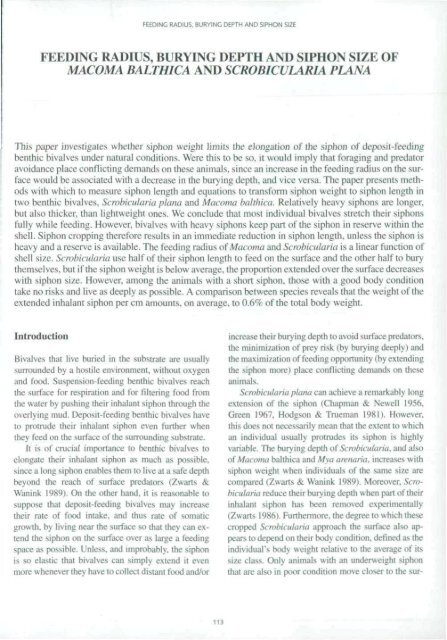waders and their estuarine food supplies - Vlaams Instituut voor de ...
waders and their estuarine food supplies - Vlaams Instituut voor de ...
waders and their estuarine food supplies - Vlaams Instituut voor de ...
Create successful ePaper yourself
Turn your PDF publications into a flip-book with our unique Google optimized e-Paper software.
FEEDING RADIUS, BURYING DEPTH AND SIPHON SIZE<br />
FEEDING RADIUS, BURYING DEPTH AND SIPHON SIZE OF<br />
MACOMA BALTHICA AND SCROBICULARIA PLANA<br />
This paper investigates whether siphon weight limits the elongation of the siphon of <strong>de</strong>posit-feeding<br />
benthic bivalves un<strong>de</strong>r natural conditions. Were this to be so. it would imply that foraging <strong>and</strong> predator<br />
avoidance place conflicting <strong>de</strong>m<strong>and</strong>s on these animals, since an increase in the feeding radius on the surface<br />
would be associated with a <strong>de</strong>crease in the burying <strong>de</strong>pth, <strong>and</strong> vice versa. The paper presents methods<br />
with which to measure siphon length <strong>and</strong> equations to transform siphon weight to siphon length in<br />
two benthic bivalves, Scrobicularia plana <strong>and</strong> Macoma balihica. Relatively heavy siphons are longer.<br />
but also thicker, than lightweight ones. We conclu<strong>de</strong> that most individual bivalves stretch <strong>their</strong> siphons<br />
fully while feeding. However, bivalves with heavy siphons keep part of the siphon in reserve within the<br />
shell. Siphon cropping therefore results in an immediate reduction in siphon length, unless the siphon is<br />
heavy <strong>and</strong> a reserve is available. The feeding radius of Macoma <strong>and</strong> Scrobicularia is a linear function of<br />
shell size. Scrobicularia use half of <strong>their</strong> siphon length to feed on the surface <strong>and</strong> the other half to bury<br />
themselves, but if the siphon weight is below average, the proportion exten<strong>de</strong>d over the surface <strong>de</strong>creases<br />
with siphon size. However, among the animals with a short siphon, those with a good body condition<br />
take no risks <strong>and</strong> live as <strong>de</strong>eply as possible. A comparison between species reveals that the weight of the<br />
exten<strong>de</strong>d inhalant siphon per cm amounts, on average, to 0.6% of the total body weight.<br />
Introduction<br />
Bivalves that live buried in the substrate arc usually<br />
surroun<strong>de</strong>d by a hostile environment, wiihout oxygen<br />
<strong>and</strong> <strong>food</strong>. Suspension-feeding benthic bivalves reach<br />
the surface for respiralion <strong>and</strong> for filtering fcxxl from<br />
the water by pushing <strong>their</strong> inhalant siphon through the<br />
overlying mud. Deposit-feeding benthic bivalves have<br />
to protru<strong>de</strong> <strong>their</strong> inhalant siphon even further when<br />
ihey feed on the surface of the surrounding substrate,<br />
li is ol crucial importance to benthic bivalves to<br />
elongate <strong>their</strong> inhalant siphon as much as possible.<br />
since a long siphon enables them to live at a safe <strong>de</strong>pih<br />
beyond the reach of surface predators (Zwarts &<br />
Wanink 1989). On the other h<strong>and</strong>, il is reasonable to<br />
suppose that <strong>de</strong>posit-feeding bivalves may increase<br />
<strong>their</strong> rate of <strong>food</strong> intake, <strong>and</strong> thus rate of somatic<br />
growth, by living near the surface so that they can extend<br />
the siphon on the surface over as large a feeding<br />
space as possible. Unless, <strong>and</strong> improbably, the siphon<br />
is so elastic that bivalves can simply extend it even<br />
more whenever they have to collect distant <strong>food</strong> <strong>and</strong>/or<br />
113<br />
increase <strong>their</strong> burying <strong>de</strong>pth to avoid surface predators.<br />
the minimization of prey risk (by burying <strong>de</strong>eply) <strong>and</strong><br />
the maximization of feeding opportunity (by extending<br />
the siphon more) place conflicting <strong>de</strong>m<strong>and</strong>s on these<br />
animals.<br />
Scrobicularia plana can achieve a remarkably long<br />
extension of the siphon (Chapman & Newell 1956.<br />
Green 1967. Hodgson & Trueman 1981). However,<br />
this does not necessarily mean lhat the extent to winch<br />
an individual usually protru<strong>de</strong>s its siphon is highly<br />
variable. The burying <strong>de</strong>pth of Scrobicularia. <strong>and</strong> also<br />
oi Macoma balihica <strong>and</strong> Mya arenaria. increases with<br />
siphon weight when individuals of ihe same size are<br />
compared (Zwarts & Wanink 1989). Moreover, Scrobicularia<br />
reduce iheir burying <strong>de</strong>pth when part of <strong>their</strong><br />
inhalant siphon has been removed experimentally<br />
(Zwarts 1986). Furthermore, the <strong>de</strong>gree to which these<br />
cropped Scrobicularia approach the surface also appears<br />
to <strong>de</strong>pend on <strong>their</strong> body condition, <strong>de</strong>fined as the<br />
individual's body weight relative to the average of its<br />
size class. Only animals vv ith an un<strong>de</strong>rweight siphon<br />
that are also in poor condition move closer to the sur-

















